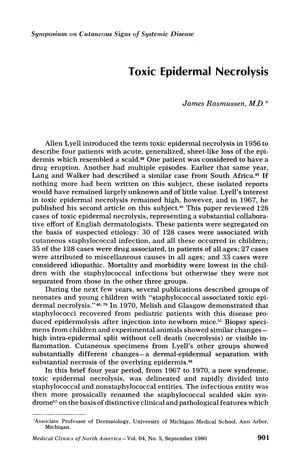Toxic Epidermal Necrolysis
September 1980
in “
Medical Clinics of North America
”

TLDR Toxic epidermal necrolysis is a severe skin condition often caused by drugs, with complex treatment and a high risk of death, but survivors usually heal without scars.
The document from 1980 by James Rasmussen, M.D., reviews toxic epidermal necrolysis (TEN), a severe skin condition with a high mortality rate. Allen Lyell's 1967 paper categorized 128 cases of TEN by suspected etiology, with drugs being the most commonly implicated agents. The condition was divided into staphylococcal and nonstaphylococcal entities, with the former being renamed staphylococcal scalded skin syndrome. TEN's etiology includes drugs, toxins, infections, and other factors, but its pathophysiology is unclear. Diagnosis is primarily through light microscopy, and while disseminated intravascular coagulation (DIC) has been observed, its significance is debated. Management of TEN is complex, with systemic corticosteroids being controversial and general treatments similar to burn care. The use of antibiotics is also debated, with recommendations to avoid them, especially sulfonamides, at the onset of TEN. Despite the high risk of mortality and complications, complete healing without scarring is common.

